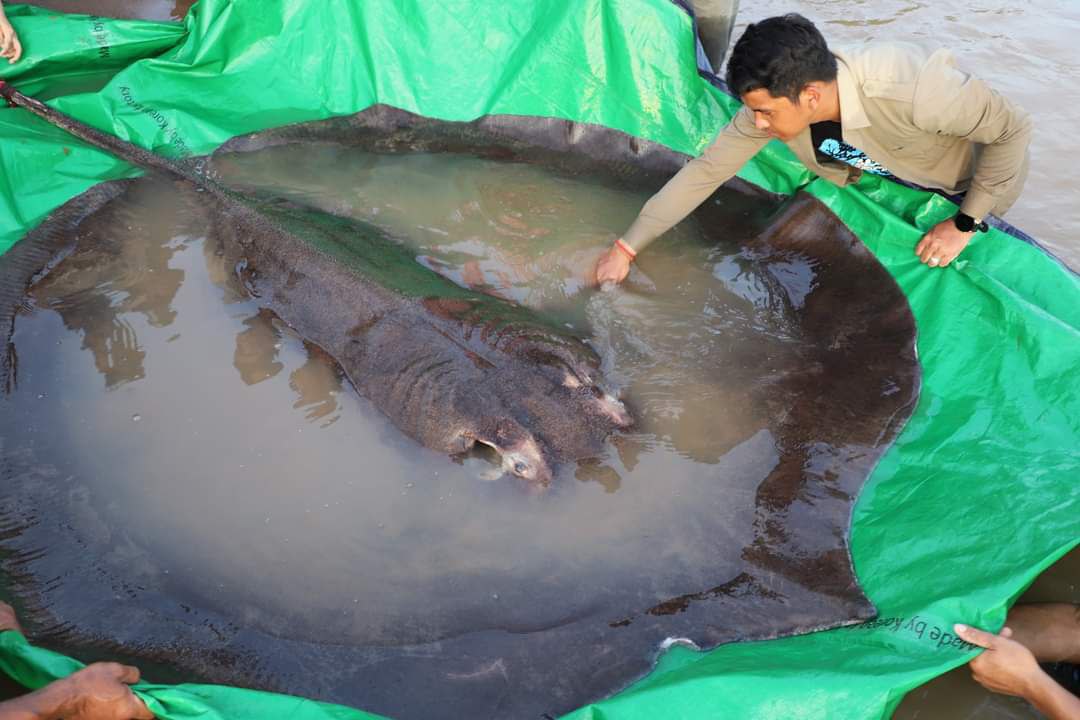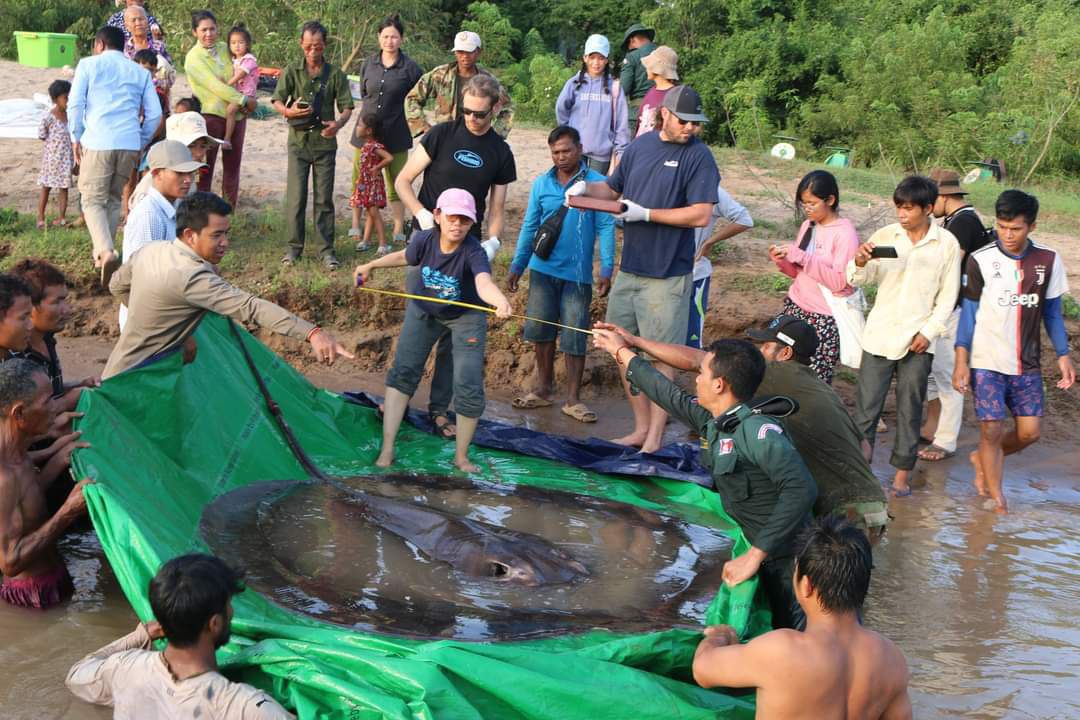ខេត្តស្ទឹងត្រែង : ប្រទេសកម្ពុជា គម្រោងស្រាវជ្រាវអច្ឆរិយភាពនៃទន្លេមេគង្គ គាំទ្រមូលនិធិដោយទីភ្នាក់ងារសហរដ្ឋអាមេរិកដើម្បីអភិវឌ្ឍន៍អន្តរជាតិ USAID បង្ហាញតម្រុយថានឹងអាចការពារបាននូវប្រភេទត្រីយក្សជិតផុតពូជនេះព្រមទាំងទន្លេដែលប្រភេទត្រីរស់នៅ។ ការរកឃើញត្រីបបែលយក្សទឹកសាបដ៏ធំមានទម្ងន់ ៣០០ គីឡូក្រាម ឬ ៦៦១ផោនកាលពីឆ្នាំមុននៅក្នុងទន្លេមេគង្គ បានចាប់ ផ្តួចផ្តើមគំនិតថ្មីមួយដោយរដ្ឋាភិបាលសហរដ្ឋអាមេរិកដើម្បីសិក្សាស្វែងយល់ និងការពារសត្វអាថ៌កំបាំងដ៏ធំបំផុតមួយនេះនៅលើភពផែនដីយើង។ នេះបើយោងតាមផេក ដែលមានឈ្មោះថា ( Wonders of the Mekong ) បានបង្ហោះ នៅថ្ងៃទី៣០ ខែឧសភា ឆ្នាំ២០២៣។
ផេក ដែលមានឈ្មោះថា ( Wonders of the Mekong ) បានបង្ហោះ ទៀតថា : អ្នកវិទ្យាសាស្ត្របានប្រសិទ្ធនាមត្រីបបែលយក្សនេះថា “បូណ៌មី” ដែលមានន័យថា “ព្រះចន្ទពេញវង់/បូណ៌មី” ។ក្នុងរយៈពេល ១២ខែមកនេះ ក្នុងកិច្ចសហការជាមួយរដ្ឋបាលជលផល ក្រុមអ្នកវិទ្យាសាស្ត្របាននឹងកំពុង តាមដានសត្វបបែលដែលបានបំបែកកំណត់ត្រាឯតទគ្គកម្មពិភពលោកមួយនេះ។ បន្ទាប់ពីគេចាប់វាបានក្នុងខែ មិថុនា ឆ្នាំ២០២២ បូណ៌មីត្រូវបានគេបំពាក់ស្លាកបញ្ជូនសំលេង (acoustic tag) មុនពេលដោះលែងទៅ ក្នុងទន្លេវិញ។ ទិន្នន័យដែលគេប្រមូលបានបង្ហាញថា ទោះបីជាវាមានទំហំខ្លួនដ៏ធំអស្ចារ្យ ប៉ុន្តែជម្រករបស់សត្វបបែលយក្សញីនេះមានទំហំតូចនៅឡើយស្ថិតនៅអន្លង់ នៃទន្លេមេគង្គភូមិភាគឦសាននៃប្រទេសកម្ពុជា ពោរពេញដោយជីវៈចម្រុះ តែស្ថិតក្រោមការគំរាមកំហែង ។
អ្នកវិទ្យាសាស្ត្រដឹងតិចតួចបំផុតអំពីបបែលយក្សទឹកសាបនេះ ខណៈពេលដែលចំនួនរបស់ពួកវាបានធ្លាក់ចុះយ៉ាងគំហុកនៅទូទាំងតំបន់អាស៊ីអាគ្នេយ៍។ ក្នុងខែនេះ ការសិក្សាស្រាវជ្រាវដែលទទួលបានការគាំទ្រមូលនិធិពីទីភ្នាក់ងារសហរដ្ឋអាមេរិកដើម្បីអភិវឌ្ឍន៍អន្តរជាតិ USAID និងបោះពុម្ពផ្សាយនិងចែករំលែកនូវលទ្ធផលប្រកបដោយគុណតម្លៃទាំងនេះ។ អ្នកស្រី ឃែរី ភែលស៍មេន នាយិការបេសកកម្មនៃទីភ្នាក់ងារសហរដ្ឋអាមេរិកដើម្បីអភិវឌ្ឍន៍អន្តរជាតិ USAID មានប្រសាសន៍ថា “ទន្លេមេគង្គដែលហូរកាត់ប្រទេសចំនួនប្រាំមួយក្នុងតំបន់អាស៊ី គឺជាជង្រុកនៃជីវៈចម្រុះរបស់សាកលលោក និងជាជម្រករបស់ត្រីប្រមាណជិត១០០០ប្រភេទដោយរួមទាំងបបែលយក្សទឹកសាបនេះផងដែរ។ អ្នកស្រីបន្ថែមថា៖ ទីភ្នាក់ងារសហរដ្ឋអាមេរិកដើម្បីអភិវឌ្ឍន៍អន្តរជាតិ USAID មានមោទកភាពណាស់ក្នុងការចូលរួមការពារអច្ឆរិយភាពទន្លេមេគង្គ និងការពារប្រភេទពូជត្រីដែលជិតផុតពូជដើម្បីជួយទ្រទ្រង់ធនធានជលផលកម្ពុជាឲ្យមានកាន់តែសម្បូរបែបដើម្បីជាប្រយោជន៍ដល់ជីវភាពរស់នៅរបស់ប្រជាពលរដ្ឋកម្ពុជារាប់លាននាក់។
លោកបណ្ឌិត ហ្សេប ហូហ្គេន សាស្ត្រាចារ្យជីវវិទ្យានៅសកលវិទ្យាល័យណេវ៉ាដារីណូ និងជាប្រធានដឹកនាំ ការស្រាវជ្រាវ របស់គម្រោងអច្ឆរិយភាពនៃទន្លេមេគង្គ ដែលគាំទ្រមូលនិធិដោយទីភ្នាក់ងារសហរដ្ឋអាមេរិកដើម្បីអភិវឌ្ឍន៍អន្តរជាតិ USAID ក្នុងការសិក្សានេះមានប្រសាសន៍ថា “ព័ត៌មានថ្មីអំពីត្រីបបែល និងត្រីជិតផុតពូជដទៃទៀតមានសារៈសំខាន់ចំពោះការការពារសត្វដែលជាតំណាងជាតិកម្ពុជា និងការអភិរក្សទន្លេដែលផ្តល់ ស្បៀងដល់មនុស្សរាប់លាននាក់”។ លោកបានបន្តថា “សត្វបបែលយក្សឥឡូវនេះបានក្លាយជាចំណុចស្នូលនៃការជជែកពិភាក្សាគ្នាដ៏ធំមួយអំពីជោគវាសនានៃទន្លេមេគង្គ និងថាតើធ្វើយ៉ាងណាឲ្យមានមានតុល្យភាពរវាង ការអភិវឌ្ឍអាងទន្លេជាមួយនឹងការគ្រប់គ្រងបរិស្ថាន ដើម្បីឱ្យទន្លេមេគង្គដ៏អសច្ចារ្យនេះអាចបន្តផ្គត់ផ្គង់ដល់ ប្រជាជនក្នុងតំបន់រាប់ជំនាន់តទៅមុខទៀត។
ជាសាកល អង្គការសហភាពអន្តរជាតិសម្រាប់ការអភិរក្សធម្មជាតិ (IUCN) បានវាយតម្លៃថាសត្វបបែលយក្ស ជាសត្វកំពុងរងគ្រោះថ្នាក់ជិតផុតពូជដោយសារតែចំនួនរបស់វាបានថយចុះ រហូតដល់ ៧៩% ក្នុងសតវត្សចុងក្រោយនេះ។
Tracking Boramy, World’s Largest Freshwater Fish, One Year Later
Stung Treng, Cambodia. The Wonders of the Mekong research project, funded by the U.S. Agency for International Development (USAID), uncovered clues that will help save the endangered megafish and the river where it lives. Last year’s discovery of a 661-pound giant freshwater stingray launched a new initiative by the United States government to study and protect one of the largest, most mysterious creatures on the planet.
The scientists dubbed the stingray “Boramy”, which means full-moon in Khmer. Over the last twelve months, in collaboration with the Fisheries Administration, scientists have been tracking the record-breaking stingray. After its capture in June 2022, Boramy was fitted with an acoustic tag before being released back into the river. The data gathered revealed that despite its enormous size, the female giant has a remarkably small home range, centered in a bio-rich but threatened stretch of the Mekong River in northern Cambodia.
Scientists know very little about the giant freshwater stingray, a species whose population has dramatically declined across its Southeast Asian region. This month, the USAID-funded studies will publish valuable findings. “The Mekong River, which runs through six Asian countries, is a global biodiversity hotspot and home to almost 1,000 different species of fish, including the world’s largest freshwater stingray,” says Kerry Pelzman, USAID/Cambodia Mission Director. “USAID is proud to join efforts to safeguard the wonders of the Mekong and to protect endangered species to help sustain Cambodia’s rich fisheries and livelihoods for millions of Cambodians.”
“This new information about the stingray and other critically endangered fish is crucial to the protection of Cambodia’s most iconic animals and the preservation of a river that provides food and livelihoods for millions of people,” says Zeb Hogan, a biology professor at the University of Nevada, Reno, who leads the USAID-funded Wonders of the Mekong research project that initiated the study. “The giant stingray is now at the center of a larger debate about the fate of the Mekong, and how to balance river basin development with environmental stewardship so that the bountiful Mekong can continue to provide for people in the region for generations to come.”
Globally, the International Union for Conservation of Nature has assessed the giant stingray as endangered due to population declines as high as 79 percent over the last century. ៕
ដោយ : សហការី












